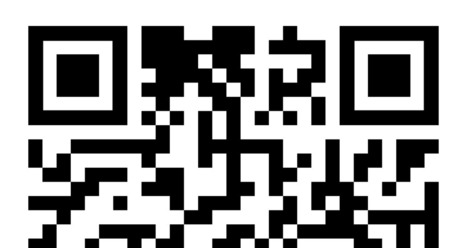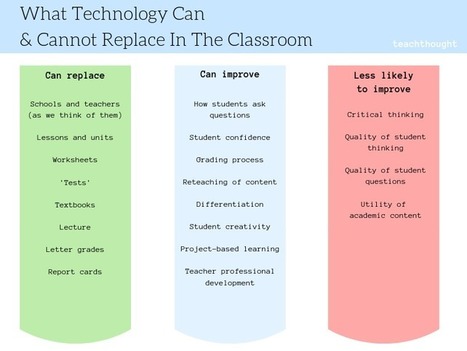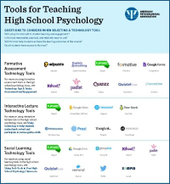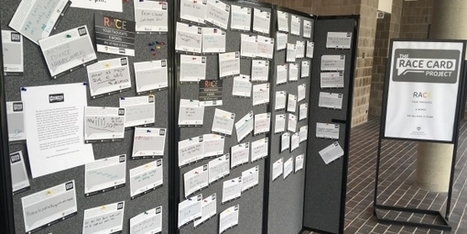While these emerging technologies may offer many benefits for students and professors, institutions will need to address ethical and safety concerns.
Get Started for FREE
Sign up with Facebook Sign up with X
I don't have a Facebook or a X account

 Your new post is loading... Your new post is loading...
 Your new post is loading... Your new post is loading...
Current selected tag: 'classroom strategies'. Clear
As it turns out, students are quite happy with HyFlex, which gives them the freedom to choose between face-to-face, synchronous and asynchronous classes. Some studies have found this flexible structure can even improve student success. “We have students who, quite literally, would have had to drop out if their courses had not been available in the HyFlex format,” Kevin Gannon, professor of history at Grand View University, writes in The Chronicle of Higher Education.
Education, as is the case with every aspect of our society, has witnessed a seismic transformation triggered by the COVID-19 pandemic. Within the first few weeks of its eruption widespread lockdowns and school closures were enforced resulting in an unprecedented disruption in the way education is being delivered. In-person learning and teaching were immediately replaced by synchronous and asynchronous modes of course delivery. Homes became the the new workspaces where learning takes place.
Back in September I wrote about and made a video about how I'm using Google Forms as a sign-in/sign-out sheet for my classroom. Some of my colleagues are doing the same thing. One of my colleagues, Erin, had the good idea to create QRs code for the forms that students use the most and post them on the classroom wall. 
Claudio Andrés Mancilla Rivera's curator insight,
November 4, 2020 10:39 PM
Una herramienta muy útil para acelerar los procesos de enlaces hacía nuevos documentos o páginas
Advantages Of Social Media In EducationSocial media and technology are vital pieces of day by day life and incorporating the utilization of these into the classroom is more normal than previously, given how adjusted numerous students are to them. Every social media stage offers various approaches to be utilized in the classroom, from sharing declarations to holding live talks, thus considerably more. It’s critical to comprehend the effect of social media in education before utilizing it, yet we’re of the firm conviction that it will help advance students in innovation.
Elizabeth E Charles's insight:
Can be used for online teaching too!
Sara Jaramillo's curator insight,
February 19, 2020 9:59 AM
I think that this article is very useful for me, someone who is going to be a teacher in the 21st century, since it suggest many ways to use the social media in my classes. It is a good method to connect with my students, because nowadays almost everyone uses technology, specially social networks and I could take advantage of this and use it in a good way. One of the suggestions that I found very interesting is the second one: Utilize a Facebook group to stream live talks and host conversations. I never thaught in the use of Facebook to communicate academic topics, or with my teachers, but the use of e-mail or skype might be boring for some students, and Facebook is tho most used social media, so me as teacher could use it to mantain contact with them, and also share some homework, or even give some classes there.
Framing questions the right way—and scaffolding the right kinds of responses—can help teachers avoid blank stares and awkward silences.
What do you do when your question is met with blank stares? In “When You Get Nothing But Crickets,” Jennifer Gonzalez of Cult of Pedagogy shares a few ways to avoid those long, awkward silences after you pose a question.
What can technology replace in the classroom? While it isn't enough to makeup for unengaging learning models, done well technology can change everything. Via EDTECH@UTRGV
The use of social media across the educational landscape is on the rise. Subsequently, the body of research on this topic is vibrant and growing. In this article, we present findings from a review of 103 peer-reviewed scientific studies published over the last decade (2007–2017) that address the use of Twitter for educational purposes across formal and informal settings. The majority of the studies reported in the literature are descriptive case studies carried out with students in North American and European higher education settings. Analysis of these studies signals Twitter as a useful tool for communication due to high accessibility, novelty, and real-time format. Students, teachers, and other stakeholders use it as a pedagogical tool to gain information, interact and engage with each other, participate in their respective communities of interests, and share their insights about specific topics. Moreover, Twitter has the potential to enhance students’ learning capabilities as well as improve their motivation and engagement due to its unique features and non-traditional teaching approach. Finally, our analysis advocates for carrying out further empirical studies focusing on digital trace data and inference, particularly in the developing countries. Via Ana Cristina Pratas
There are many technology-based tools that can be helpful for classroom teachers, and sorting through them to find ones that may be useful can be challenging. This web page describes pedagogical categories of technology tools for teachers; an infographic of useful technology tools (PDF, 275KB) grouped by the categories below is also available so that teachers can more easily identify which technology tools may be of use to them. Teachers who may not use technology might want to start with just one tool, while those who are more familiar with some technology are encouraged to try a new tool that suits their classroom purposes.
Technology has undeniably and profoundly expanded access to education in many ways. For one thing, classroom walls have dissolved in the wake of these advancements providing new ways of learning. With classroom social media, a new age of education is dawning and teachers can be a catalyst for educational change.
Last fall, professors told us about their plans to experiment this year with technology-enabled teaching. Now they reflect on the successes and shortcomings.
Using immersive technology, student nurses can perfect their stitches and criminals see the consequences of their actions. In this post, I explore today’s practical applications of virtual and augmented reality (VR and AR) to see how it may benefit education.
Wendy Sadler is a lecturer at Cardiff University, and the founder of science made simple . These are her six simple tips to become a science communicator.
You don't need to speak slowly all the time. You can use pauses to bring down the average speed. |
If we are to bring about lasting changes around the use of technology in teaching and learning in colleges and universities, we need to understand the practices that staff undertake and the challenges they face. Effective and sustained change comes from a place of working in service to pedagogies, and practices that support and surround learning and teaching. In order to better understand these issues Jisc commissioned research to gain more understanding about practice around learning and teaching and gaining insights beyond the technology-led.
What does it mean to infuse equity, inclusion, and diversity into your classroom? Most importantly, what does it mean to your students to provide them with a sense of belonging? These questions aren’t easy, but they are necessary to foster an inclusive classroom and to diversify your content. From culturally responsive teaching, inclusive classroom strategies, teaching diverse learners, gender diversity, and more, we’ll cover an array of topics and strategies you can learn about and start implementing in your own courses to help students feel seen and heard. From articles, free reports, programs, seminars, and courses, this resource guide will present ideas, tools, and techniques that you can start using right away.
Groupwork is a valuable part of a student’s experience as it gives them the opportunity to work with peers and develop more confident teamwork and communication skills (amongst many other skills). In the classroom this activity can take place by asking the students to sit together in groups or if in a lecture theatre type classroom form groups of pairs by row and then one pair turn around to form a four with the pair behind. You might ask the groups to find a space of their own and return to the classroom after a set time. In these smaller groups students can be asked to work on a problem, engage in discussions, or any other activity they can work on collaboratively.
You’re committed to equity and inclusion. You’ve been educating yourself about how higher ed systemically and systematically privileges some and disadvantages others, while working to create a just and equitable experience for minoritized students. Active learning pedagogies are already part of your toolbox, and you support your department’s ideas on curricular change. Still, you aren’t quite sure how to translate your commitment into further action. What’s next?
One method of teaching that has become popular is the flipped or inverted classroom in which students do homework during class and then watch videos with the course material at home. The concept is so much more involved, especially for teachers who want to teach it well. Here is why you should consider flipped learning in your classroom.
I credit my husband as the inspiration for this article. He is a writing professor who is exceptionally good at waiting. He has a unique ability (and probably disturbing to some) to ask his students a question and then wait…wait through the awkward silence, wait through the students’ sideways glances and shifting in desk chairs until a brave student decides to volunteer and answer his question. His willingness to wait inspires me and has challenged me to use this technique with my own students. Interestingly, there is a lot of research on teacher’s use of waiting in the classroom and the positive effects it can have for student engagement and learning. The best news of all? Improving student learning only takes 3 seconds.
Creating a successful learning experience is at the heart of instructional design and delivery. “In addition to academic instruction, one of a classroom’s teachers most important roles is to help students develop the critical thinking, collaboration, and self-reflection skills necessary to foster a better society” (Blacke, 2015, para. 1). Encouraging students to explore the topics of power and privilege resulting from social classifications and their impact on the thoughts and actions of themselves and others is an important step toward encouraging social justice. However, creating a classroom environment that facilitates and supports discussions about sensitive topics can be challenging.
The rise of social media is one of those trends, and by its nature, it appears like it’s here to stay! And its adoption is increasing regardless of a person’s age. According to this research, by January 2019, there have been 3.4 billion active social media users around the world. Even young children, who are barely beginning to speak, want a piece of it while they are eating - they won’t open their mouth unless their favorite song is played on YouTube!
It’s happening again. I feel the sentence structure at a subdermal level and know I’m confronting plagiarism before my eyes reach the period. A quick Google search reveals that my ninth-grade student did not write this sentence: “The memories stirred by the song cause Odysseus to weep, and, though he tries to hide it, the king notices and distracts the crowd by suggesting they begin an athletic competition.”
Growth mindsets aren't just for students. It helps for teachers to have a growth mindset about their students' mindsets, too.
Welcome to Teaching, a free weekly newsletter from The Chronicle of Higher Education. This week:
“ After spending more than a decade supporting college faculty in teaching, I have heard students utter these statements numerous times. I often observe classes and conduct mid-course focus groups with students. It continues to surprise me that students regularly question how the readings connect to class. Certainly, instructors would not be assigning readings that had nothing to do with the course! Given how much we worry about students not doing the readings, why would we assign unrelated readings? Yet, frequently, in courses in different disciplines, I’ve heard this type of feedback from students, “We don’t understand the readings, they have nothing to do with what we talk about in class.” |

































